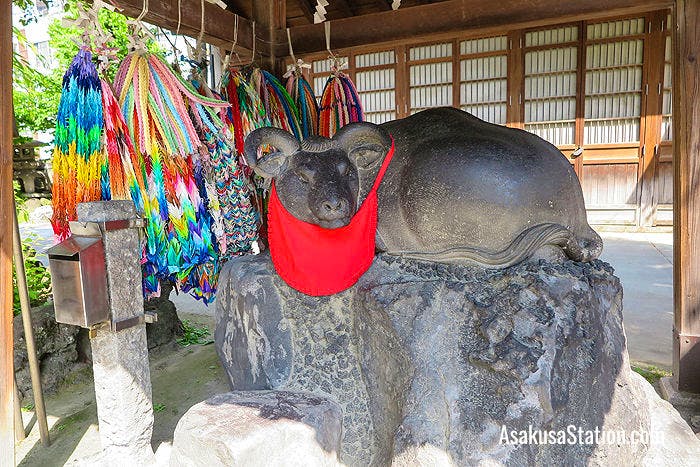Ushijima Jinja is a shrine of the Shinto religion which is located inside Sumida Park on the east bank of the Sumida River.

The entrance to Ushijima Jinja
The History of Ushijima Shrine
Ushijima Jinja was founded in 860 by the Buddhist priest Ennin (also called Jikaku Daishi). Ennin was visiting the area in order to view the famous golden statue of the goddess Kannon at Sensoji Temple. One day he was out walking in the area when an old man appeared and started talking to him. The old man told Ennin that he should build a shrine to protect the people who lived on the east side of the Sumida River. The old man then revealed himself to be Susanoo, the Shinto god of storms.

The unusual mitsutorii gate with the worship hall behind it
Ennin had the shrine built and it was dedicated to three gods: Susanoo, the god of storms; Amenohohi, a son of Amaterasu the sun goddess; and Sadatoki Shinno, a deified imperial prince who died while visiting this area in 929. These three gods protect the people living on the east bank of the Sumida River, just as the goddess Kannon who is worshipped at Sensoji Temple protects the people on the west bank. Because Ushijima Jinja is dedicated to three gods, it has an unusual torii gate with three entrances which is called a mitsutorii.

A carved dragon at the front of the worship hall
The main buildings of the shrine are built of hinoki cypress wood. Above the entrance to the worship hall you can see a beautifully carved dragon. In Japanese tradition, dragons are spirits of the water, rivers and rain, so they can protect people from fire and bring good weather for farmers and fishermen.
The Patting Cow
The name of the shrine “Ushijima” literally means “cow island” and it is possible that this area was once a grassy island in the Sumida River where people kept their cows. There are many statues of cows around the shrine, and this shrine also has a pair of guardian koma-ushi cow statues in front of the main building instead of the usual pair of koma-inu or lion-dogs.

One of many cow statues at Ushijima Jinja
The most important cow statue is the “nade-ushi” or “patting cow” which is a bronze statue located to the right of the main hall.

The nade-ushi or “patting cow”
There is a common folk belief in Japan that stroking or patting a statue of a reclining cow will help with health problems. If you have a health problem in a particular part of your body, you should pat the same part of the body on the cow. So if you have back pain, stroke the cow’s back. However, the nade-ushi’s powers are not restricted to healing health problems. Simply patting the cow is believed to bring good luck, business success, and a variety of other blessings. The nade-ushi at Ushijima Jinja has a red bib tied around its neck like a bib you might give a small infant child. There is a tradition that bringing new born babies to this nade-ushi will protect them from disease.
The nade-ushi tradition seems to have its origins in a cow-headed god called Gozu-Tenno. This is a god of Indian origin who has the power to protect people from epidemics of disease. As the storm god Susanoo also protects against disease, these two gods are sometimes regarded as the same.
Ushijima Jinja Grand Festival
A grand festival called Ushijima Jinja Taisai is held at this shrine every five years. This festival includes a two day parade of local people in traditional costumes and as the main attraction a richly decorated imperial-style carriage pulled by two black bulls. On the third day there is a lively parade of 50 local portable shrines. This grand festival takes place every five years over 3 days from September 15th – 17th and the next one is due to be held in 2022.
Location
Ushijima Jinja is located inside Sumida Park on the east bank of the Sumida River. It is a 12 minute walk from the Toei, Tokyo Metro, and Tobu Asakusa stations, and 9 minutes from Tokyo Skytree Station. Here is a map showing its location.
Article and original photos by Michael Lambe. All rights reserved.
